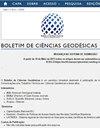POINT TO POINT: AN ALTERNATIVE METHOD FOR EXTRACTING “HOMOLOGOUS POINTS” IN BATHYMETRIC DATA COLLECTED WITH A MULTIBEAM SYSTEM
IF 0.5
Q3 Earth and Planetary Sciences
引用次数: 0
Abstract
Abstract: Due to waterway transport efficiency, mainly for commercial trades, the use of sea/river routes has grown recently. So, the importance of producing high quality nautical charts stands out. A nautical chart is the hydrographic survey final product and its accuracy depends on data quality collected, primarily of the vertical quality (depth). In this sense, despite the theoretical and practical difficulty in obtaining homologous points in hydrographic surveys, even when performing check lines, bathymetric data must always be delivered with a statistically proven confidence level. Thus, this study has two main objectives: i) to propose a method, called Point to Point (P2P), for obtaining “homologous points” for hydrographic surveys carried out with multibeam systems, without resorting to mathematical and/or statistical interpolations, called Point to Point (P2P); ii) to quantify the magnitude of the difference between the statistical evaluation using check lines (CL) and by overlapping successive sounding lines (SL), applying the P2P method. The results showed that P2P is easy to application, provide low computation effort, is robust and consistent. Besides that, was possible to applied successive regular lines to get a validation of the hydrographic survey.点对点:在多波束系统收集的测深数据中提取“同源点”的另一种方法
摘要:由于以商业贸易为主的水路运输效率的提高,近年来海运/内河航线的使用有所增加。因此,制作高质量海图的重要性凸显出来。海图是水文测量的最终产品,其准确性取决于所收集的数据质量,主要是垂直质量(深度)。从这个意义上说,尽管在水文调查中,即使在进行检查线时,在理论上和实践上都难以获得相应的点,但提供的水深数据必须始终具有经统计证明的置信水平。因此,本研究有两个主要目标:i)提出一种称为点对点(P2P)的方法,用于在使用多波束系统进行水文测量时获得“同源点”,而无需诉诸称为点对点(P2P)的数学和/或统计插值;ii)采用P2P方法,对使用检查线(CL)和重叠连续测深线(SL)进行统计评价的差异程度进行量化。结果表明,P2P具有易于应用、计算量小、鲁棒性好、一致性好等优点。此外,还可以应用连续规则线对水文测量结果进行验证。
本文章由计算机程序翻译,如有差异,请以英文原文为准。
求助全文
约1分钟内获得全文
求助全文
来源期刊

Boletim De Ciencias Geodesicas
Earth and Planetary Sciences-General Earth and Planetary Sciences
CiteScore
1.70
自引率
20.00%
发文量
10
审稿时长
3 months
期刊介绍:
The Boletim de Ciências Geodésicas publishes original papers in the area of Geodetic Sciences and correlated ones (Geodesy, Photogrammetry and Remote Sensing, Cartography and Geographic Information Systems).
Submitted articles must be unpublished, and should not be under consideration for publication in any other journal. Previous publication of the paper in conference proceedings would not violate the originality requirements. Articles must be written preferably in English language.
 求助内容:
求助内容: 应助结果提醒方式:
应助结果提醒方式:


